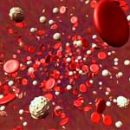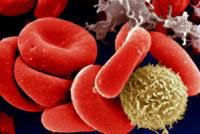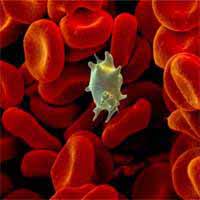What is thrombocytopena? What are the manifestations of this disease? How the thrombocytopenia is treated? Answers to these and other questions you will find in the article.
Content
Thrombocytopenia (low blood platelet levels) - one of the common HIV-associated states. This is one of the few problems that can be associated directly with the virus itself, and not with its influence on the immune system. This article describes in more detail what thrombocytopenia is, and what methods of its treatment.
Thrombocytopenia - means shortage, low blood platelet levels. Another name of platelets - blood plates. These are very small blood cells of the wrong shape, in which there is no kernel. Platelets are produced by megacariocytes - huge cells that are in the Red Bone Brain.
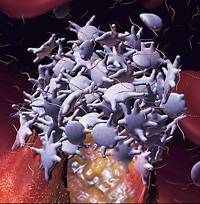 Platelets are necessary for blood clotting. If the surface of any blood vessel is broken, and blood begins to flow from it, sticky blood plates of irregular shape literally clocked damage in the vessel wall. Thus, platelets prevent bleeding and blood loss. If there were not platelets in the body, then a person could die of any bleeding, including internal, invisible for him.
Platelets are necessary for blood clotting. If the surface of any blood vessel is broken, and blood begins to flow from it, sticky blood plates of irregular shape literally clocked damage in the vessel wall. Thus, platelets prevent bleeding and blood loss. If there were not platelets in the body, then a person could die of any bleeding, including internal, invisible for him.
Thrombocytopenia can develop at HIV-positive people for various reasons. The first reason is that HIV infects megakaryocytes, which means that HIV in itself can lead to a lack of platelets. Secondly, some drugs against HIV may damage the red bone marrow (for example, some nucleoside inhibitors of reverse transcriptase). The same applies to some disease at the stage of AIDS (for example, lymphoma or poppy).
Another reason may be that the immune system can produce antibodies that are directed against healthy platelets of the body. This condition is called thrombocytopenic purpura (or hemorrhagic purpura). Such antibodies are called autoantibodies, and the state is autoimmune, which means that the body produces antibodies «against himself». Autoantibodies are served by a spleen signal that destroys and removes platelets from the body.
The normal number of platelets should be from 150,000 to 400,000 per milliliter of blood. With very severe cases of thrombocytopenia, the number of blood plates can be close to zero. With moderate thrombocytopenia, the number of platelets is 100-150 thousand per milliliter. If the number of platelets becomes below 30,000 - it means a high risk of uncontrolled bleeding, including hemorrhage to the brain, in other words - stroke.
Platelets are also carriers of serotonin and L-tryptophan - two substances that are involved in the regulation of sleep / wake cycles, appetite and emotional states. Therefore, theoretically thrombocytopenia can lead to disorders of sleep and disorders of mood (depression).
Manifestations of thrombocytopenia
Many people with thrombocytopenia, especially moderate, do not notice any specific symptoms. With more severe cases of thrombocytopenia, it can lead to different problems with bleeding.
These problems include:
- Frequent and excessive nose bleeding.
- Appearance on body bruises «without any reasons» (purpura).
- Too strong bleeding with wounds.
- Women have excessive bleeding during menstruation.
The only correct way to diagnose thrombocytopenia is to determine the level of blood platelets. All HIV-positive people are advised to regularly hand over a general blood test, which includes the determination of platelet levels. Common blood test is usually done once every 3-6 months, together with an analysis of immune status (immunogram) and an analysis of the viral load (the amount of blood virus). Thus, if a HIV-positive person regularly goes to a doctor and gives blood tests, the doctor will definitely determine the thrombocytopenia long before it can lead to serious problems.
Treatment of thrombocytopenia
The most effective treatment for thrombocytopenia in HIV people is highly active antiretroviral therapy (Vaart). Antiretroviral drugs dramatically reduce the level of virus in the blood, and thus do not give HIV infecting megacariocytes. Highly active antiretroviral therapy also «Soothes» The immune system, that is, makes it less active, which slows down the process of producing autoantiboders, promoting thrombocytopenia. Thus, highly active antiretroviral therapy is the first treatment method, which is usually suggested during thrombocytopenia. In the event that highly active antiretroviral therapy is inefficient, there are other methods of treatment.
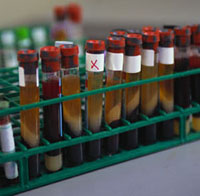 Presenice. Presenice is a drug from class steroids, similar to hormone cortisone. This drug has many indications for use, including it is used to treat immune thrombocytopenic purpura, as it «Soothes» Hyperactive immune system, which can lead to platelets. Long-term reception of prednisone for people with HIV is problematic because it can suppress the immune system.
Presenice. Presenice is a drug from class steroids, similar to hormone cortisone. This drug has many indications for use, including it is used to treat immune thrombocytopenic purpura, as it «Soothes» Hyperactive immune system, which can lead to platelets. Long-term reception of prednisone for people with HIV is problematic because it can suppress the immune system.
Gamma Globulin. Injection Gamma Globulin can be assigned independently or with prednisone to increase platelet levels. This drug is administered intravenously with a dropper of about 4-6 hours, and is usually prescribed to receive every 1-3 days.
Anti-D Globulin. This drug applies only for some people with immune thrombocytopenic purple. It prevents the destruction of thrombocyte spleen. It is also assigned in the form of intravenous injections.
Splenectomy. Such an operation is also called splenectomy. The spleen destroys platelets when their autoantibodies attack them, and its removal theoretically should lead to curable from immune thrombocytopenic purprapure. Nevertheless, such a method of treatment is extremely rare, and it is usually never prescribed if all other means are not tried, less serious.
Thrombocytopenia - a condition that can develop from any person, even with a fairly high immune status, regardless of external factors. However, although the thrombocytopenia itself is often found in people with HIV, its serious and dangerous forms -. If antiretroviral therapy is most likely available, most HIV-positive will be taken before they can develop this condition.
For HIV-positive people, it is important to regularly pass tests, including a general blood test, even if they feel well and do not take any treatment. This allows you to determine such deviations as thrombocytopenia, and take measures before it can lead to problems with bleeding.

